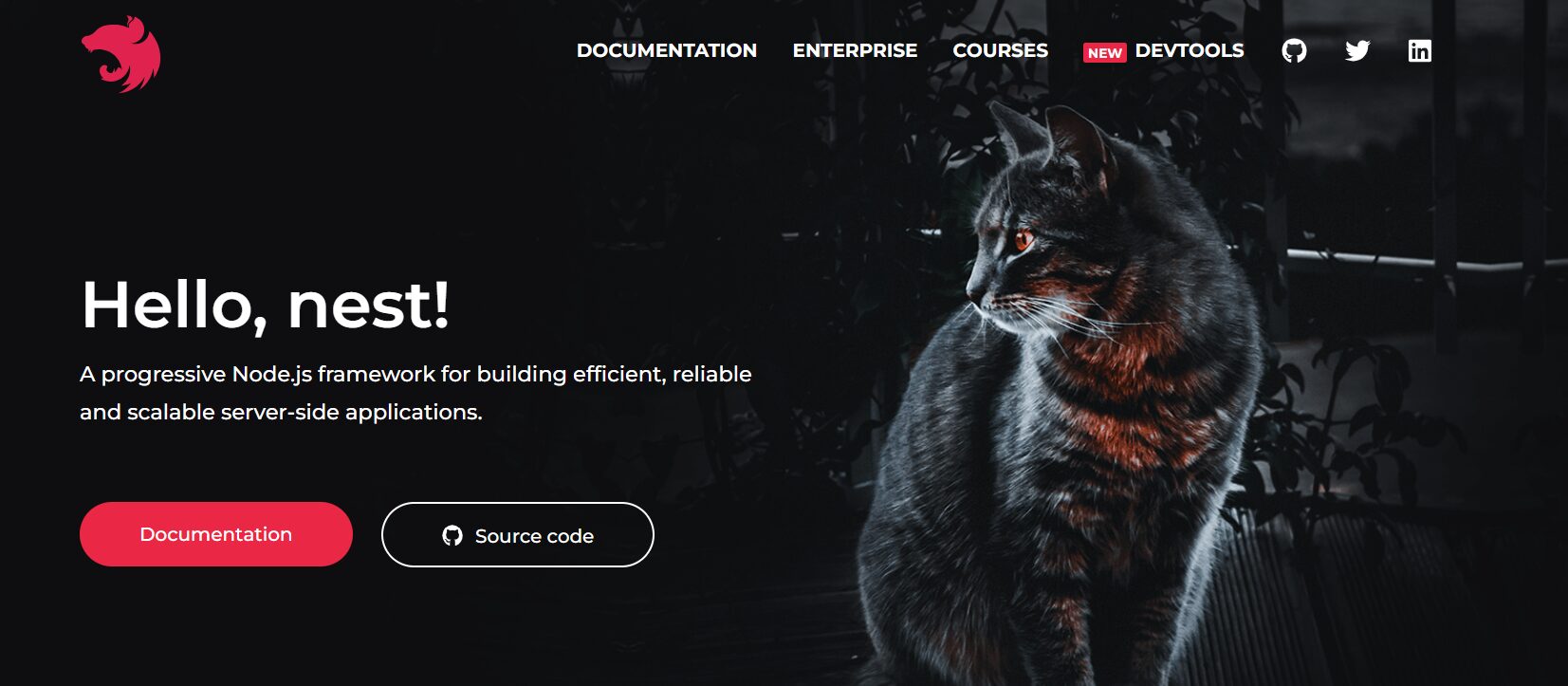Table of Contents
Introduction
Developers are searching for frameworks that deliver a powerful punch in terms of robustness and efficiency in the constantly changing world of server-side applications. This is where NestJS, a powerful JavaScript framework, comes into the picture and dares to challenge the status quo.
Based on the powerful Node.js platform, NestJS has managed to win over the trust of developers all over the world. To ensure the success of software projects, developers can follow these 10 best practices for custom software development, making it a force to be reckoned with. Today we will take a closer look at the nuances of NestJS and deep dive into its sought-after benefits.
What is NestJS?
NestJS is a progressive JavaScript framework which is built on top of Node.js. It gets its inspiration from Angular’s architecture and can seamlessly apply it to server-side development.
Thus, it can present developers with a familiar and well-structured approach to crafting applications. NestJS makes full utilization of TypeScript, a statically typed superset of JavaScript. For security-driven development, our DevSecOps solutions integrate security from the start. Efficient API development plays a crucial role in this ecosystem, as highlighted in our blog on best API design for mobile apps. Thus, it provides better tooling, better code maintainability, and better error handling.
One of the standout characteristics of NestJS is how modular its architecture is. This follows best practice when it comes to microservices architecture, which increases scalability and maintainability. which enhance scalability and maintainability. This revolutionary method encourages programmers to group and package related functionality into modules, resulting in a completely new level of reusability and concern separation. Furthermore, NestJS simplifies scaling your application for you while also adding new features. Otherwise it would have been indeed a daunting task for you!
NestJS has emerged as the go-to framework for developers who are looking for a reliable and effective foundation. All thanks go to its magnetic appeal and rising popularity. Now, let’s take a look at the features that make NestJS stand apart, shall we?
Top-Notch Features of NestJS
Modular Architecture
In fact, NestJS does support the active use of modules to structure and encapsulate similar functionality. The modular style is useful in fostering reusability and separation of concerns. In addition, it makes it easier to scale and add new features to the application.
Because here they are following a modular design, developers can build applications that are simpler to maintain and also support streamlined testing procedures. To keep software optimized over time, explore our sustenance engineering services for long-term support and maintenance.
TypeScript Support
TypeScript lies at the core of NestJS. This provides developers with the capabilities of static typing in the environment of Node.js. Through TypeScript integration, errors can be caught early while still in development, which implies fewer bugs and a better quality of code. TypeScript introduces aspects such as type checking, automatic code completion, and improved code navigation. As a result, developers can write code that is cleaner and more dependable.
Decorator-Based Syntax
NestJS uses decorators to define routes, middleware, and other vital components of the application. This expressive syntax makes code readability and maintainability better. It also allows developers to attach metadata to classes, properties, or methods.
Essentially, decorators provide a neat and effective way to add features and configure different parts of your application.
Dependency Injection
NestJS embraces the concept of dependency injection only to simplify the management and testing of application components. Dependency injection facilitates loose coupling between different parts of the application. This is how it promotes code reusability and modular development. This flexibility, then, empowers developers to easily replace or mock dependencies during the testing phase.
Benefits of Using NestJS
Embracing TypeScript’s Power
NestJS is indeed an ingenious framework because of how it harnesses the extraordinary power of TypeScript. Ensuring code quality is key in every software project. Our software quality engineering services provide testing and automation solutions. It seamlessly integrates TypeScript into the Node.js ecosystem, and then takes code maintainability to never-seen-before heights. All this, while significantly reducing those pesky runtime errors that can plague developers!
TypeScript gives developers the facility of autocompletion, improved code navigation, and the wonderful ability to detect potential issues early on in the development process. Therefore, the dynamic duo of NestJS and TypeScript ensures that developers can create more resilient code and can also catch errors before they have a chance to wreak havoc in production.
The Command Line Interface (CLI) Paragon
NestJS is not just a framework—it’s a productivity powerhouse. All because of its robust Command Line Interface (CLI). This CLI is the one that saves the day by streamlining the entire development process.
Developers now have powerful tools capable of generating modules, controllers, services, and various other application components. And all they have to do is utter a few simple commands. Developers no longer need to waste their precious time and effort on repetitive tasks and the laborious creation of project structures.
The CLI extends its benevolent capabilities further by offering automatic import resolution, code generation, and masterful project configuration management. With such formidable prowess, developers can channel their focus toward crafting the very essence of their applications, unburdened by the shackles of manual setup and configuration.
The Open Source Realm
NestJS is indeed the true champion of the coding community. Why, it is a proud open-source framework released under the illustrious MIT license! Because it’s open-source, NestJS has a lively community – here people can get involved, work together, share knowledge and find the best ways of doing things.
Developers everywhere can help NestJS grow when they contribute to the code, report bugs they find, or suggest new features that could change how things work. The MIT license gives developers the freedom to use, change, and share NestJS for any kind of project – it can be for business or personal use. And there’s nothing to worry about strict licensing rules!
This incredible flexibility means that you can use NestJS in all sorts of projects. Also, its widespread use paves the way for continuous innovation, isn’t it?
Unveiling the Simplicity of Unit Testing
We have NestJS to thank, now that the often complicated task of unit testing applications has become much easier. The framework has been designed very simply. It offers built-in testing tools that work smoothly with popular testing frameworks like Jest.
NestJS has a modular design which is a big advantage. This is how NestJS helps you easily separate different parts of your application and test them individually. Other features of NestJS include the dependency injection, and creation of mock versions of external services. Thus, developers using NestJS can easily set up test cases, and also mimic real-world situations. Furthermore, NestJS even supports end-to-end (e2e) testing. Therefore, developers can thoroughly test the entire application from beginning to end.
The Lighthouse of Documentation
NestJS can very well boast of its extensive and meticulously maintained documentation. They serve as an invaluable resource for developers seeking knowledge.
This amazing resource covers an impressive range of topics. They include the installation and configuration to the core concepts, architectural patterns, and even more advanced features.
The documentation does not merely present dry explanations. It also accompanies them with detailed examples and carefully crafted code snippets. These, then, can transform complex ideas into easily digestible morsels.
Future of NestJS
Even in 2025, NestJS is still going strong, known for its well-organized structure, efficiency, and ability to be expanded. Having gained over 50,000 stars on GitHub, it boasts a lively community that actively helps improve it. By easily incorporating the newest technologies, NestJS is set to continue being a top pick for developers who want reliable and adaptable solutions in the fast-changing world of web development.
Conclusion
Indeed, NestJS has become a hot favorite among developers in recent times. This has happened because of the well-organized structure of NestJS, its use of TypeScript, familiar way of writing code, and the strong support it receives from its dedicated community. NestJS uses the power of Node.js and TypeScript to help developers build strong and efficient applications that can handle the requirements of modern software development.
Ultimately, it is quite clear that NestJS is the future. It generously allows programmers to take full advantage of everything it has put on offer. Now is the perfect time to make use of its wide range of benefits and also make it a key part of most software development projects.
A Product Engineering Company with an unmatched reputation, Wishtree Technologies provides solutions to an array of clients, including Fortune 500 companies, Thoma Bravo, Vista Equity Partners, UN Agencies (WHO, UNDP, World Bank) Nonprofits, and Startups.
Contact us today for a free consultation.






